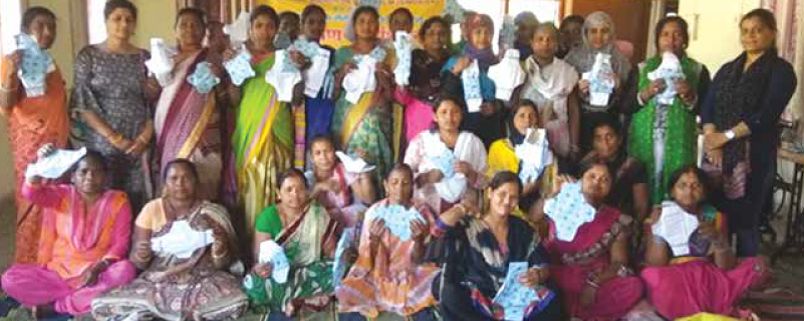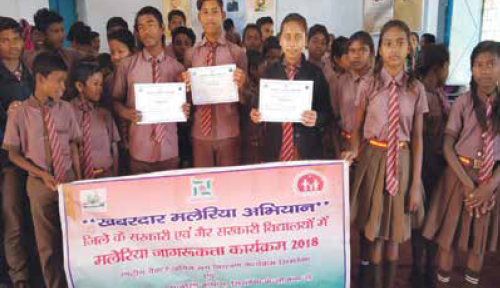Garima Abhiyan
Garima Abhiyan
Garima Abhiyan
 A stigma around menstruation and menstrual hygiene still prevails among a large section of people in the Simdega district. The Garima Abhiyan, which translates to Dignity Campaign, was designed to sensitise women, children as well as men about Menstrual Hygiene Management (MHM). The campaign was throttled, in collaboration with a UN agency Water Sanitation Supportive & Collaborative Council (WSSCC), which helped the district administration as a knowledge and logistics partner. 65 frontline workers from health, education, self-livelihood and social welfare departments of the district were chosen and were given training by Subject Matter Experts (SME) coming from WSSCC, on Training for Trainers (ToT) mode. Utilizing these 65 ‘Master Trainers’, more than 3000 frontline workers were further trained on the campaign. Workshops were organized in all the 774 schools and 964 Anganwadi Centres of the district. Further, a group of 450 team leaders, who were well equipped with the subject matter were given the name of ‘Garima Fauj’ (Dignity Army) and were motivated to organize a village level workshop in all the 450 villages of the district.
A stigma around menstruation and menstrual hygiene still prevails among a large section of people in the Simdega district. The Garima Abhiyan, which translates to Dignity Campaign, was designed to sensitise women, children as well as men about Menstrual Hygiene Management (MHM). The campaign was throttled, in collaboration with a UN agency Water Sanitation Supportive & Collaborative Council (WSSCC), which helped the district administration as a knowledge and logistics partner. 65 frontline workers from health, education, self-livelihood and social welfare departments of the district were chosen and were given training by Subject Matter Experts (SME) coming from WSSCC, on Training for Trainers (ToT) mode. Utilizing these 65 ‘Master Trainers’, more than 3000 frontline workers were further trained on the campaign. Workshops were organized in all the 774 schools and 964 Anganwadi Centres of the district. Further, a group of 450 team leaders, who were well equipped with the subject matter were given the name of ‘Garima Fauj’ (Dignity Army) and were motivated to organize a village level workshop in all the 450 villages of the district.
A movement called ‘Chuppi Todo’ was started to encourage people to talk openly about menstrual welfare. To make the movement more engaging, Pad man was screened in the village in different locations and this was well received by the community. The next agenda in the project following the awareness drives was to assure the availability of affordable, biodegradable and convenient sanitary napkins in the area. The district mobilized a group of 100 trained SHG women members to stitch 100% biodegradable and chemical free sanitary napkins by themselves using cotton clothes. The product was well received by the community. The administration is now looking forward to set up local production units by mobilizing all the trained SHG members and promoting the brand in the name of ‘Miss Garima Sanitary Pad’. Simdega now envisions to become India’s first menstrual waste free district by eradicating the practice of using conventional sanitary napkins which contain plastic and chemicals and replacing the same by its very own domestically produced economical napkins.
Garima Campaign has impacted and touched more than one lakh out of total six lac people of the Simdega district. Talking about menstruation was no longer a taboo after the men were asked to train women; male teachers were asked to train female students, and female teachers were asked to train male teachers. This has led to people openly discussing menstruation in Simdega.
With the combined efforts of the Simdega administration and the ADF’s, Simdega is indeed leading today in assuring equality and equity to women as well as promoting and sensitizing people of all ages and genders about menstrual hygiene.
Health Awareness Campaigns
 Awareness is the first step in making any society a healthy society. Being an aware individual is by default a strong character of a responsible citizen. In the spirit of spreading awareness, an ambitious vision to strengthen its human resources by boosting their awareness about disease’s spread and control through campaigns was initiated.
Awareness is the first step in making any society a healthy society. Being an aware individual is by default a strong character of a responsible citizen. In the spirit of spreading awareness, an ambitious vision to strengthen its human resources by boosting their awareness about disease’s spread and control through campaigns was initiated.
Simdega is one of the most malaria prone districts of India, largely because 69% of the tribal population is unaware of the harmful repercussions of water logging. To address this, the first campaign was ‘Khabardaar Malaria Campaign’ in which around 300-400 students of the district were trained for identifying breeding spot of mosquitos and destroying them
The next in line was ‘Bhaag Filaria Bhaag Campaign’, which came as a prerequisite for implementation of IDA Program – A triple drug therapy for Lymphatic Filariasis, in the district. Simdega was one of the five non-endemic districts of India which were chosen for launching IDA program. Tuberculosis was attacked by launching ‘TB Bhagao Campaign’. Lack of awareness about nutritional requirement of TB’s treatment therapy i.e. DOTS and about its consequences, forced patients to run away from treatment, which further used to advance their TB’s status to HDR (High Drug Resistant) and XDR (Extreme Drug Resistant). The only way to take patients in confidence was to make them aware and prepared enough for DOTS treatment.
In all these campaigns, the strategy remained the same. Every department had funds available under IEC head, which earlier were used, either for just displaying banners or running a propaganda vehicle. However, that didn’t help the administration much in reaching to those who are at the bottom of the pyramid. So, the campaign mode emerged as the long-awaited intervention in such a picture. The strategy was to first create a set of master trainers by organizing workshops by SMEs (Subject Matter Experts) on Training of Trainers (ToT) mode. Subsequently, these master trainers were utilized judiciously, in conducting workshops at school and village level and hence broadening the outreach base.
The number of annual active malaria patients came down in Simdega. Today, TB patients can be seen, taking the DOTS treatment seriously and following it properly.
Simdega has indeed used ‘awareness building’ as a fuel for propelling engine of health in the district. It looks forward to following the same strategy for keeping a check on several other issues i.e. AIDS Control, Leprosy etc. Undoubtedly, the district has shown example ‘good health governance’.
The district marked a grand success by meeting 100% target for drug’s outreach. Simdega now envisions to become a filarial free district in coming years.
Source : Public System Strengthing in Aspirational Districts
Last Modified : 8/23/2021
This topic provides information about Champions of...
This topic discuss reharding Safe motherhood, Comp...
This topic covers the importance of deworming in c...
This topic covers about Hygiene and some Key messa...
